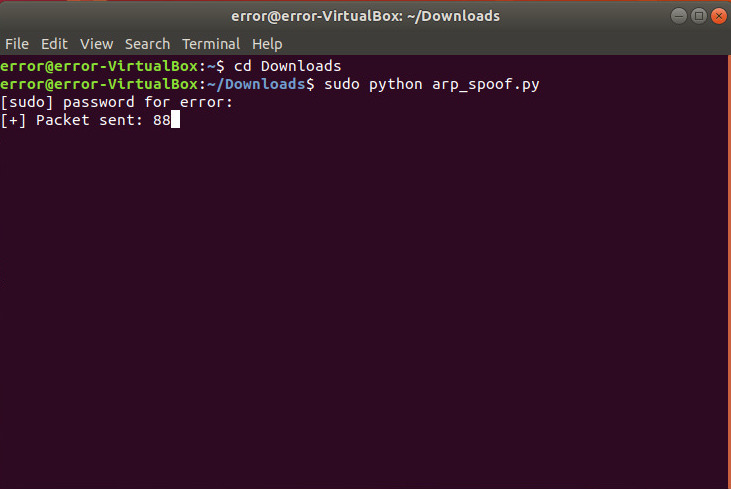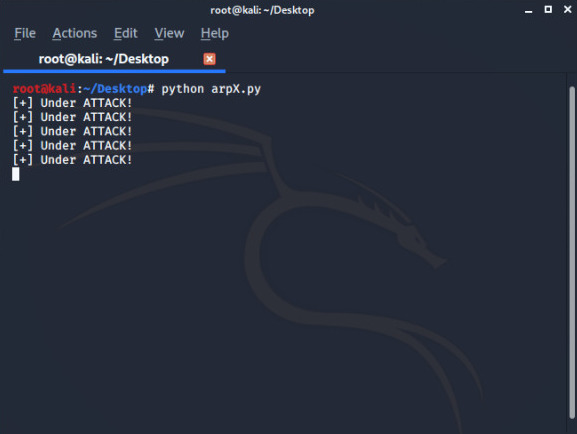ARP SPOOF DETECTOR
In this writeup we will build a tool which can detect am ARP SPOOFING attack.
IMP NOTE: We will be using some concepts and code from our writeups on ARP SPOOF AND PACKET SNIFFER so make sure read it once and if you already done than go with the flow.
The easiest way to detect any arp attack is to monitor arp tables you can this by the command :
root@kali:~# arp -a
you can see the changes in arp table by doing an arp_spoof attack to one of your device it chnages once attack happens.
arp -a have one issue it works fine until you are not being attacked but after an arp_spoof attack it stills shows MAC address of eth0/wlan0 interface because it get restored but their is far better to detect this if you took spoof function from our arp_spoof cod(which sends an arp response to fool router and victim).
def spoof(target_ip, spoof_ip):
target_mac = get_mac(target_ip)
packet = scapy.ARP(op=2, pdst=target_ip, hwdst=target_mac, psrc=spoof_ip)
scapy.send(packet, verbose=False)
In order to send a ARP response we set op = 2 and destination(pdst) to target IP and hwdst to Target MAC and psrc to the router’s IP we can use this code and sniffer code.
network_scanner.py
#!/usr/bin/env python
import scapy.all as scapy
from scapy.layers import http
def sniff(interface):
scapy.sniff(iface=interface, store=False, prn=process_sniffed_packet)
def get_url(packet):
return packet[http.HTTPRequest].Host + packet[http.HTTPRequest].Path
def get_login_info(packet):
if packet.haslayer(scapy.Raw):
load = packet[scapy.Raw].load
keywords = ["username", "user", "login", "SignIn", "password", "pass", "SignUp"]
for keyword in keywords:
if keyword in load:
return load
def process_sniffed_packet(packet):
if packet.haslayer(http.HTTPRequest):
url = get_url(packet)
print("[+] HTTP Request >>>" + url)
login_info = get_login_info(packet)
if login_info:
print("\n\n[+] Possible Credential >>>" + load + "\n\n")
sniff("eth0")
Since, we don’t need the entire code lets do some refactoring:
#!/usr/bin/env python
import scapy.all as scapy
def sniff(interface):
scapy.sniff(iface=interface, store=False, prn=process_sniffed_packet)
def process_sniffed_packet(packet):
if packet.haslayer(http.HTTPRequest):
sniff("eth0")
But instead of HTTP layer we need to analyse ARP layer to check the ARP response.
#!/usr/bin/env python
import scapy.all as scapy
def sniff(interface):
scapy.sniff(iface=interface, store=False, prn=process_sniffed_packet)
def process_sniffed_packet(packet):
if packet.haslayer(scapy.ARP) and packet[scapy.ARP].op == 2:
print(packet.show())
sniff("eth0")
if packet.haslayer(scapy.ARP) and packet[scapy.ARP].op == 2 > check for ARP layer in scapy packet and op == 2 for ARP response.
Now if you run this code you will see nothing until you run a arp_spoof attack first from another device (for testing pupose only) , once you do this all details of packets will be displayed and under ARP list you will see hsrc(the MAC Address) of attacker pretends to be the router and again if you scroll down their will be similar reponse for target .So basically they pretends to be diifernt devices but if we can cross check that a certain IP have that specific MAC Address or not (based on ARP Protocol) and if found that a certain IP doesn’t have legitimate MAC address than we get to know that it is pretending to be a different device sand for this we have function which return MAC if we input IP (code from arp_spoof).
Lets add both the code to create the final code:
arpX.py
#!/usr/bin/env python
import scapy.all as scapy
def get_mac(ip):
arp_request = scapy.ARP(pdst=ip)
broadcast = scapy.Ether(dst="ff:ff:ff:ff:ff:ff")
arp_request_broadcast = broadcast / arp_request
answered_list = scapy.srp(arp_request_broadcast, timeout=1, verbose=False)[0]
return answered_list[0][1].hwsrc
def sniff(interface):
scapy.sniff(iface=interface, store=False, prn=process_sniffed_packet)
def process_sniffed_packet(packet):
if packet.haslayer(scapy.ARP) and packet[scapy.ARP].op == 2:
try:
real_mac = get_mac(packet[scapy.ARP].psrc)
response_mac = packet[scapy.ARP].hwsrc
if real_mac != response_mac:
print("[+] Under ATTACK!")
except IndexError:
pass
sniff("eth0")
BREAKDOWN —
# to get real_mac of devices
real_mac = get_mac(packet[scapy.ARP].psrc)
# to get response_mac from scapy packet
response_mac = packet[scapy.ARP].hwsrc
# comparing the two MAC if not same it's attack
if real_mac == response mac:
print("[+] Under ATTACK!")
Code is ready for test run arp_spoof attack from another device run this code on victim machine to Test !
For testing you can use our arp_spoof.py

After attack run the arpX.py to detect:

You can get all the neccessary codes from author Githubrepository.
I hope you enjoyed this writeup and learnt something new if you have any queries feel free to ask in comments box or contact us through mail, or have suggestions for improvements ? We’d love to hear you, send us an email!